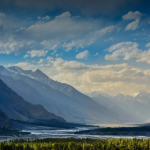In a Glimpse
The epitome of natural beauty marked with geographic variety, countless trekking trails, and ever changing landscapes, Astore valley stretches at the eastern face of Nanga Parbat and southeast of Gilgit. The valley has a rich cultural and historical background besides being the hub to access many significant tourist attractions around Skardu Valley in the Gilgit-Baltistan region.

Astore Valley is located in the Gilgit-Baltistan region of northern Pakistan. The valley, at an altitude of 2600m above sea level, is an amazing place to visit while on a journey through beautiful Pakistan. The total area of 5,000 km², spreading over 120 km makes it difficult for visitors to explore the entire valley in just one visit.
Astore is famous for its stunning natural beauty, including the scenic Astore Valley and Rama Meadows. It serves as a gateway to Deosai National Park, known for its unique wildlife and landscapes. The region offers trekking and mountaineering opportunities, particularly to Nanga Parbat. Astore is also noted for its rich cultural heritage and diverse ethnic groups.
The Astore Road is a 115 km long metalled road leading you to the mountain town of Astore, the capital of Astore district in Gilgit Baltistan. The road ends at the Burzil Pass.
Topography and Climate
The climate of Astore Valley is moderate during summer; neither hot nor cold. Bu, in winter heavy snowfalls up to 4-6 feet cause temperatures to drop immensely. Most of the valley remains snow-clad from October to April.
The whole valley landscape features arid plains giving rise to sharp, rocky mountains on either side, turning into lush green fertile meadows at small distances.
The mighty Nanga Parbat accompanies the landscape in the background all along as you traverse Astore Valley. Following River Astore, the valley with more alpine features takes you to the giant glaciers presenting the wild and aggressive side of the valley
The vigorous climate conditions and mesmerizing landscape confers great significance to this valley, making it home for the growth of medicinally valued plants.
Accessing Astore Valley
There are two ways to approach Astore Valley; from Skardu and Astore via Deosai National Park is approximately 140 kilometers by road, the other one is direct from Karakoram Highway to Astore valley. Distance from Islamabad is 494 km, an 11.5 hrs drive along River Indus, whereas, distance from Raikot Bridge to Astore is 55 km, a 1.5 hrs drive.
Astore is accessible from Gilgit via Jaglot as well by Jeep, a 4-5 hours drive covering 120 Kms. You can access the valley only on four-wheel-drive vehicles.
Skardu-Deosai route remains closed from November to June due to heavy snow and landslides. As most of the valley constitutes remotely located villages, land phones are the only communication channel with the outside world in these months.

Attractions in Astore Valley
Astore is the hub to access many tourist attractions, surrounded by Diamer in its west, Gilgit in the north, Skardu in the east, and Neelum district in the south. Besides the picturesque and enigmatic landscape of Astore valley itself, Astore is the central point to accessing many natural attractions specifically in the Skardu region.
The valley’s enormous dimensions comprise unrivaled jewels as Deosai Plains, Rama Lake, and Rupal Valley in the surrounding areas. Astore Town is renowned for its versatile natural beauty and access to some of the world’s unique mountain attractions.
Rama Meadows followed by Rama Lake is at a distance of about 10-11K from Astore. Rama Valley is at a higher altitude than Astore and jeeps take more than an hour to reach Rama Meadows and Rama Lake.
On this historical route, Dar Lay Lake, a 5-6 hours drive away is a profoundly captivating site.
The Chronicle of Astore
The Astore valley presents historical splendor of Gilgit Baltistan region in Pakistan. For centuries, Gibians used the Astore road to maintain commercial connections with Kashmir through trade and travel. People used to travel to Srinagar for study and trade purposes, mostly to import Kashmiri fabrics.
Through the generations, people from all across the region made countless trips through Astore valley. These travels contributed to the linguistic and cultural diversity of the valley. It also contributed in major settlement of Sunni Muslims belonging to Wahhabi sect in Astore valley. In contrast, all other areas of Gilgit Baltistan region have only Shia muslims making the community.
According to the Imperial Gazetteer of India, “around 1600, Ghāzī Mukhpun, a Persian adventurer, is said to have married a princess of the Skārdu reigning family.
The four sons born of this union became Rās of Skārdu, Astor, Rondu, and Kharmang. From them descended the families of present chiefs of those areas. Afzal, Guada, Chilma were sons of Astor. They lived in Juttay, Ganda gam (Arzalabad), Gudai (Guadabad), Chilm (Chilmabad) respectively”.
Folks of Astore
The cultural and historical background of the valley is intriguing, but the valley indeed has much more to offer. Astore valley has around 100 villages inhabited by 70,000 people.
The remoteness of the valley has inhibited these villagers’ socialization; however, the people of Astore valley are very hospitable.
If you want to connect with locals on a deeper level, Astore is the best place to visit in Gilgit Baltistan region. While traveling you will find that the inhabitants of the valley are simple people. They manage to lead a life of self-subsistence and their hospitality is beyond bounds.
Accommodation
There are no hotels in the valley except very few small arrangements in Astore Valley. However, if you intend to stay, mingling with locals may present you with an offer or invitation to stay in their house. Least you will surely be offered “Tumoro”, the largely used herbal tea in Astore.



